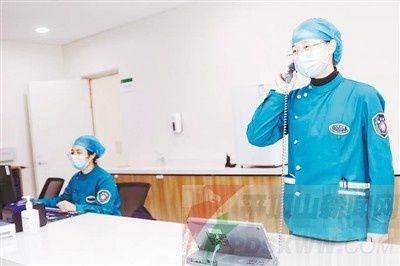
The medical staff is answering the emergency call. Photo by Wang Junhao
The emergency department of the new hospital of the first hospital is located on the east side of the first floor of the outpatient building, with an area of 3820 square meters It has a scientific and efficient layout and a complete information system. It undertakes the four-in-one emergency treatment task of pre-hospital emergency, in-hospital emergency, intensive care, and rehabilitation. Critically ill patients can complete inspection, diagnosis, rescue, monitoring, treatment, surgery, etc. on the same floor, truly embodying the “one-stop emergency” service. Its modern, standardized and intelligent software and hardware facilities have built a healthy barrier for guarding the “lifeline” of the people of Yingcheng.
Guarding the life and health of critically ill patients
On the second day of the lunar new year, 52-year-old Jiaxian patient Liu Yunhua (pseudonym) had a sudden headache at 4:00 a.m. The local hospital’s emergency CT scan showed that Subarachnoid hemorrhage is in critical condition, and the emergency transport network is quickly opened with the new hospital district of the first hospital in the city. One hour later, the patient was transferred to the emergency department of the new hospital district of the first hospital of the city. The admission staff escorted the whole process, and the green channel was unblocked all the way. CTA examination showed: the left internal carotid artery posterior communicating segment aneurysm. After the cause was identified, the doctor communicated with the patient’s family about the condition. Li Wen, director and chief physician of the emergency department and intensive care unit, led the neurointervention team to perform emergency aneurysm embolization for the patient, which quickly and accurately relieved the aneurysm bleeding crisis. After the operation, the intensive care department seamlessly connects monitoring and treatment, and the patient is transferred to the general ward after the patient’s condition is stable. The emergency team of the new hospital saved the patient’s life with excellent neurointerventional technology.
Recently, a patient named Li, who lives in the urban-rural integration demonstration area of the city, suffered from dizziness, inflexible left lower extremity movement, and slurred speech. A rapid head CT examination was performed through the stroke green channel, and the initial diagnosis was acute cerebral infarction caused by large vessel occlusion in combination with symptoms. Time is life. After examining the patient, Li Wen decisively decided to undergo intravenous thrombolysis first. With the consent of the patient’s family, he was immediately given 63 mg of alteplase for thrombolytic therapy. At the same time, the head and neck CTA examination showed that the left internal carotid artery was occluded. Li Wen communicated with the patient’s family again and started mechanical thrombectomy. The patient’s consciousness improved after the operation, and he was transferred to the general ward for treatment after his condition was stable under the supervision of the intensive care department. At present, the patient is recovering well, walking freely, and has been discharged smoothly. The patient was very grateful and said that the city hospital gave him a second life.
Create a fast, smooth and safe life-saving channel
In recent years, the First Municipal Hospital has successfully completed the certification of National Advanced Stroke Center, China Chest Pain Center, Atrial Fibrillation Center, and Heart Failure Center. The emergency and critical care system has been fully optimized and upgraded. As the “vanguard” of the emergency system of the four major centers, the emergency department of the new hospital relied on a more standardized and efficient central platform when it was opened, played a powerful “green channel” role, and created a fast, smooth and safe escort for the people. rescue channel.
There are 70 staff in the emergency department of the new district of the first hospital, 28 emergency observation beds, 46 intensive care beds (39 ICU, 7 EICU), and one emergency standard operating room. There are 120 pre-hospital emergency stations and 3 ambulances (including 1 negative pressure ambulance and 2 monitoring ambulances). The 5 standardized rescue units are equipped with multi-function rescue beds, cardiopulmonary resuscitators, mild hypothermia therapy devices, mobile ultrasound machines, (invasive/non-invasive) ventilators, mobile ventilators, EEG monitors, and cerebral oxygen monitors. Instrument, brain pressure monitor, BIS monitor, TCD, CRRT, bronchoscopy, extracorporeal membrane oxygenation equipment (ECMO) and other rescue equipment, emergency treatment facilities and equipment are at the leading level in the province.
As the head of the department, Li Wen’s academic part-time jobs include the standing committee of the Neurosurgery Branch of the Neurosurgery Professional Committee of the Henan Provincial Medical Association, the vice chairman of the Neurosurgery Branch of the Henan Provincial Popular Science Medical Association, and the Henan Provincial Neurological Intervention Professional Committee. Member, Henan Stroke Professional Committee, Henan Neurosurgery Youth Committee, Henan Neurosurgery Neuroendoscopy Professional Committee, Pingdingshan Medical Association Neurosurgery Standing Committee, Pingdingshan Medical Association Neurosurgery Professional Deputy Chairman. He also won the titles of Advanced Worker of the Municipal Health System, Winner of the Municipal Youth Science and Technology Award, and Municipal Academic and Technical Leader. (Li Ying)